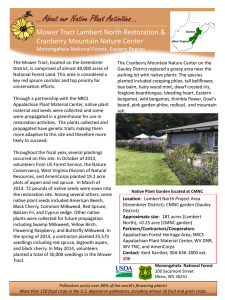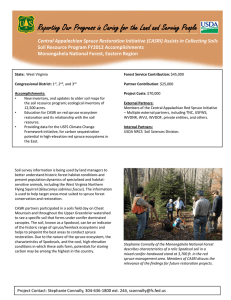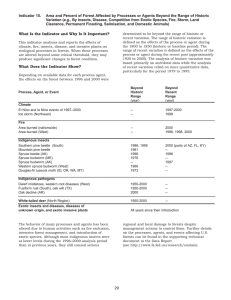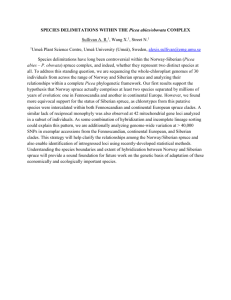typographus (L.) (Col., Curculionidae, Scolytinae) infestation during outbreak in northeastern Poland
advertisement
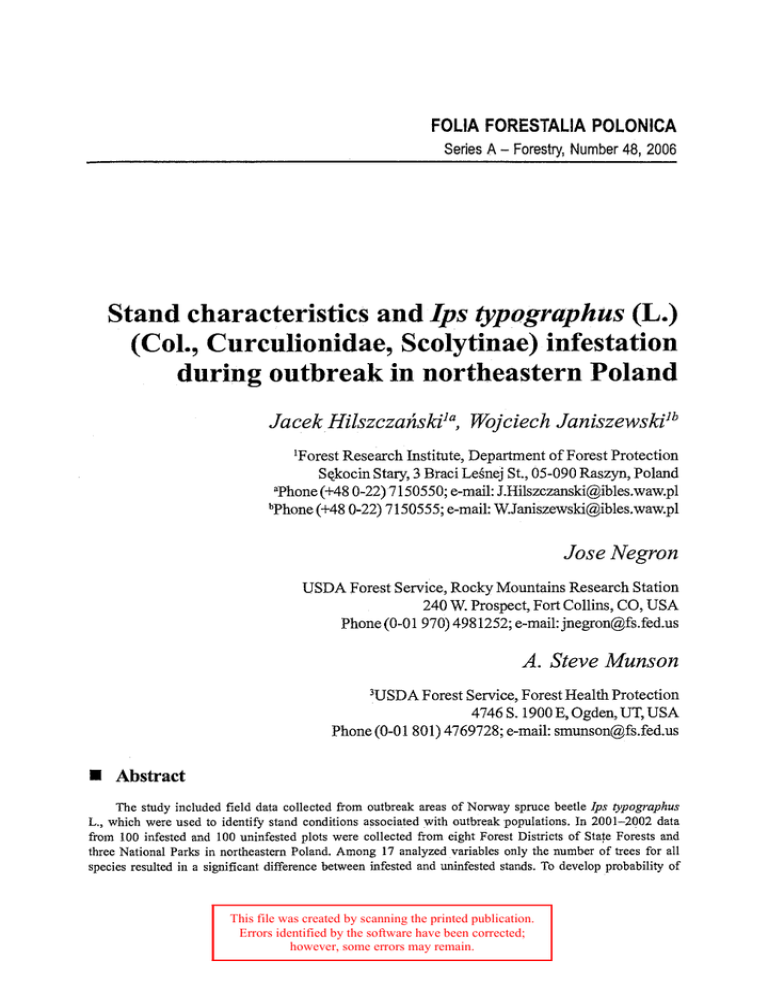
FOLlA FORESTALIA POLONiCA Series A - Forestry, Number 48, 2006 Stand characteristics and Ips typographus (L.) (Col., Curculionidae, Scolytinae) infestation during outbreak in northeastern Poland Jacek Hilszczahskiia, Wojciech Janiszewskiib 'Forest Research Institute, Department of Forest Protection Sqkocin Stary, 3 Braci LeSnej St., 05-090 Raszyn, Poland "hone (t48 0-22) 7 150550;e-mail: J.Hilszczanski@ibles.waw.pl bPhone(+48 0-22) 7 150555; e-mail: W.Janiszewski@ibles.waw.pl Jose Negron USDA Forest Service, Rocky Mountains Research Station 240 W. Prospect, Fort Collins, CO, USA Phone (0-01 970) 4981252; e-mail:jnegron@fs.fed.us A. Steve Munson 3USDAForest Service, Forest Health Protection 4746 S. 1900 E, Ogden, UT, USA Phone (0-01 801) 4769728; e-mail: smunson@fs.fed.us H Abstract The study included field data collected from outbreak areas of Norway spruce beetle Ips typographus L., which were used to identify stand conditions associated with outbreak populations. In 2001-2002 data from 100 infested and 100 uninfested plots were collected from eight Forest Districts of State Forests and three National Parks in northeastern Poland. Among 17 analyzed variables only the number of trees for all species resulted in a significant difference between infested and uninfested stands. To develop probability of This file was created by scanning the printed publication. Errors identified by the software have been corrected; however, some errors may remain. 54 Jacek Hilszczaliski, Jose Negron, Wojciech Jaiziszewski, A. Steve Muizson infestation models, a statistical technique called Classification and Regression Trees (CART) was used. Results of classification models indicate increased probability of infestation when stand density index for all species of trees present declines below 14.1 per plot (0.02 ha) (about 0.6 of common density index used in polish forestry) and for stands with a high percentage of spruce (> 92.2 percent). Keywords Ips typographus outbreak, stand characteristics Introduction The Norway spruce beetle Ips typographus L., is a major disturbance agent associated with Norway spruce, Picea abies Karst. in Poland. Thousands of cubic meters of infested wood are removed from forested areas annually. Sanitationpractices are considered to be the most effective method of limiting I. typographus activity (Wermelinger, 2004). Often a large number of infested and susceptible down, damaged, and standing trees are salvaged during ongoing outbreaks of the bark beetle. Outbreaks are usually initiated by various disturbances like windthrow, severe drought, or serious weakening of the trees caused by pathogenic fungi (Lieutier, 2004). Such trees attract beetles by releasing host volatiles (Lindelow et al., 1992). Norway spruce beetle outbreaks occur periodically in northeastern Poland every several years (Hilszczanski and Kolk, 2001) when forest patches infested by I. typographus are commonly observed within a matrix of spruce and mixed stands. The principle objective of this research was to develop a Norway spruce beetle susceptibility-rating system that would be applicable to forest areas in northeastern Poland. It was found that several site and stand factors are associated with characteristics that increase a tree's susceptibility to bark beetle attack: tree age, exposition, bark anatomy, altitude, soil nutrients, water supply, etc. (Lieutier, 2004; Lobinger et Skatulla, 1996;JakuS, 1998; Dutilleul et al., 2000; Lexer, 1997). Stand characteristics that can be manipulated using silvicultural treatments to reduce the susceptibility of spruce to bark beetle attacks are of interest to the forest management community (Negron, 1998; Wermelinger, 2004). Characteristicsthat can be vegetatively manipulated include: age class diversity, stand density, proportion of spruce and species composition. To develop guidelines for managers it is very important to understand how those characteristics are related to probability of Ips infestation. In this experiment, data was collected from 100 plots infested by I. typogmphus and 100 uninfested plots. Research objectives associated with this study were: Are there any differences in stand characteristics between infested and uninfested plots that affect stand susceptibility to this insect? Are specific stand characteristics quantifiable to develop probability of infestation and stand susceptibility model? Research Design and Methodology The geographic area of the study was limited to northeastern Poland because of the similarity in forest conditions found throughout this area. Stand characteristics Ips typographus (L.) (Col. Curculionidae, Scolytinae)... 55 To develop models that estimate the probability of infestation by bark beetles, 100 plots (0.02 ha, 7.98 m radius) were established in current or previously infested sites and 100plots (75 m in a random direction from the infested plot) in an uninfested site. Study plots were located away from the forest edge in the interior portion of the stand where populations of I. typographus are typically found. The center point for each infested plot was established randomly and often close to the initially infested tree within the polygon of dead and infested hosts. The following data were collected for each plot: tree diameter and species for all trees greater than 7 cnl diameter at breast height dbh, tree height, crown position (dominant, codominant, intermediate, suppressed) previous 12-year radial increment (one or two spruce trees per plot were sampled for all crown position classes except suppressed), CI tree status (live, beetle-killed, fungus-killed or dead from other causes). With this information we calculated mean tree diameters, quadratic mean diameter, total height, basal area, stand density index and trees number per plot for all species and for spruce only. We also calculated percent of basal area in spruce, mean and total spruce radial growth for the last 12 years, periodic growth rates and mean height for all dominant and codominant spruce. Periodic growth rate was obtained by dividing the last 10 years growth by the 10 previous years. Stand density index was calculated using individual tree contribution to stand density as: Z (dbh / 25) '.6(Long and Daniel 1990). Stand density index is a measure of competition between trees in the stand and is a relationship between tree diameter and trees number per unit area (Long 1985;Long and Smith 1984). All data were collected during the field seasons in 2001 and 2002. Field data for all plots occurred on the following Forest Districts of State Forests and National Parks in Poland: Krynki Forest District, Suprail Forest District, Suwalki Forest District, Hajn6wka Forest District, Browsk Forest District, Bialowieza Forest District, Strzalowo Forest District, Czarna Bialostocka Forest District and Bialowieski National Park, Biebrzanski National Park, Wigierski National Park. A statistical technique called Classification and Regression Trees (CART) was used to develop probability of infestation models to determine tree and stand parameters associated with host susceptibility to Norway spruce beetle. This technique examines all levels of all variables to identify which one best splits the data into the most pure classes (Breiman et al. 1984). Wilcoxon sign rank test was used for paired comparisons between infested and uninfested plots. Results and Discussion The number of all trees in all plots by diameter class shows the dominance of younger trees indicating abundant undergrowth (Fig. 1). The largest diameters represent single old oak trees, which were sometimes present in mixed stands. Norway spruce trees were concen- 56 Jacek Hilszczaiiski, Jose Negron, Wojciech Janiszewski, A. Steve Mulzson 7.5 12.5 17.5 22.5 27.5 32.5 37.5 42.5 47.5 52.5 57.5 62.5 67.5 diameter class [cm] 72.5 92.5 112.5 FIG. 1. Number of all trees per 5 cm diameter classes across all plots (diameters indicate midpoint of size) 7.5 12.5 17.5 22.5 27.5 32.5 37.5 42.5 47.5 diameter class [cm] 52.5 57.5 62.5 67.5 FIG. 2. Number of Norway spruces per 5 cm diameter classes across all plots (diameters indicate midpoint of size) 72.5 TABLE 1 Descriptive statistics for all variables measured within all surveyed plots Variable per plot N Range Minim Maxim. Mean Stat. statistic statistic statistic statistic std. error Std. deviation Variance statistic statistic Sum basal area all spp 200 1.74 0.37 2.12 0.8858 0.0180 0.25521 0.065 Stand density index all spp 200 25.76 6.93 32.69 15.2758 0.2786 3.93970 15.521 Mean dbh cm all spp 200 33.83 16.50 50.33 29.3414 0.4287 6.06209 36.749 Mean height all spp Spruce mean dbh Spruce mean height Sum spruce basal area 200 1.30 0.16 1.46 0.6317 0.0174 0.24551 0.060 Stand density index spruce 200 20.58 3.13 23.72 10.9702 0.2726 3.85452 14.857 Number of trees all spp 200 33 4 37 11.44 0.3300 4.72700 22.348 Qmd all ~ P P 200 32.42 18.73 51.15 32.4540 0.4370 6.18044 38.198 Number of spruce 200 33 2 35 8.06 0.3100 4.44300 19.741 Qmd for spruce 200 40.87 17.22 58.08 33.1052 0.5810 8.21650 67.511 Mean rad growth 9 1-99 189 3.79 0.36 4.15 1.4869 0.0439 0.60317 0.364 Mean total growth 91-99 189 34.09 3.24 37.33 13.3818 0.3949 5.42851 29.469 Percent basal area spruce 200 83.45 16.55 100 72.3638 1.5337 21.69027 470.468 Mean pgr 189 2.95 0.38 3.33 1.2588 0.0262 0.35987 0.130 Mean height of dom and co-dom spruce 190 28 16.60 44.60 29.2711 0.2863 3.94690 15.578 Abbreviations used: Dbh - diameter at breast high, Qmd - quadratic nlean diameter, rad - radial, pgr - periodic growth ratio , dom- dominant, co-dom- codoxnilant, spp - species 58 Jacek Hilszczahski, Jose Negron, Wojciech Janiszewski, A. Steve Munson trated in the 22 to 33 cm diameter classes (Fig. 2), which reflect the general age structure of managed Norway spruce stands in Poland. Table 1 presents a summary of stand conditions observed across all plots sampled. Among measured variables only the number of trees for all tree species per plot registered a significant difference between infested (Table 2) and uiliilfested plots (Table 3) with higher numbers observed in uilinfested plots. Although there is a difference in the number of trees between infested and uninfested sites, the sum basal area for all species was similar in both types of sampled plots. Studies conducted by Baier (1996) and Negron (1998) indicate reduced growth could be a symptom of reduced tree vigor, which increases susceptibility to bark beetle infestation. Although some decrease of annual radial increment in infested plots was recorded compared to healthy plots (Fig. 3), the differences are statistically not significant. Forest protection management practices associated with stand density and its effect on spruce beetle behavior have recently been incorporated into forest management assessments in mountain habitats (Netherer et Nopp-Mayr, 2005). No research efforts have been previously conducted to detennine the density threshold associated with increased susceptibility to bark beetle attack. The classification tree model (model 1) (Fig. 4) as result from this study indicates increased probability of infestation when stand density index for all tree species in the plot falls below 14.1 (0.02 ha), what could be compare with about 0.6 of stand density according to common density index popular in Polish forestry. Stand density index proposed by Long and Daniel (1990) is easy to obtain because is not dependent on species, height of the tree and quality of the site. Stand density index appears to be a good predictor variable to determine susceptibility. Larger number of trees uninfested plots has a distinct effect on light conditions and lower stand density indexes result in more light and less shaded conditions. Stands with increased light are more susceptible, which is an important variable for spruce bark beetle (Jaku5, 1998). Previous studies indicate for some bark beetle species that host tree composition affects susceptibility to bark beetle infestation (Schmid et Frye, 1976; Furniss et al., 1979;Netherer et Nopp-Mayr, 2005). As the percentage of spruce increases within a stand, the susceptible tree component is more likely to occur compared to mixed species stands with some species more resistant to windthrow and bark beetle attacks (Jactel et al., 2001). YEARS FIG. 3. Average yearly i~lcrementof spruce trees on infested and uninfested plots TABLE 2 Descriptive statistics for infested plots Varkbk per plot N Stat. statistic statistic statistic statistic Sum basal area all spp 100 1.74 0.37 2.12 0.8595 Stand density index all species 100 25.76 6.93 32.69 14.7662 Mean dbh cm all spp 100 32.53 17.81 50.33 29.7991 Range Mmm Maxim Mean Std.deviatbn Variance Std. error statistic statistic 0.0276 0.27561 0.076 0.4266 4.26562 18.195 0.6549 6.54907 42.89 Mean height all spp 97 19.83 17.63 37.45 25.1637 0.4629 4.55935 20.788 Spruce mean dbh 100 36.33 17.42 53.75 3 1.2920 0.7921 7.92076 62.738 Spruce mean height 97 23.05 14.40 37.45 25.2534 0.5138 5.06076 25.611 Sum spruce basal area 100 1.08 0.16 1.23 0.6179 0.0252 0.25216 0.064 Stand density index spruce 100 17.86 3.13 20.99 10.7039 0.4008 4.00768 16.061 Number of trees all spp 100 23 4 27 10.79 0.4300 4.3210 18.673* Qnidall ~ P P 100 29.36 21.79 51.15 32.8545 0.6539 6.53908 42.760 Number of spruce 100 22 2 24 7.54 0.3700 3.7050 13.726 Qnidfor spruce 100 35.54 18.88 54.42 33.3965 0.7855 7.85467 61.696 Mean rad growth 91-99 94 2.72 0.36 3.08 1.4105 0.0536 0.51992 0.270 Mean total growth 91-99 94 24.49 3.24 27.73 12.6946 0.4826 4.67927 21.896 Percent basal area spruce 100 83.45 16.55 100 73.4161 2.2994 22.99394 528.721 Mean pgr 94 2.95 0.38 3.33 1.2283 0.0394 0.38213 0.146 Mean height of dom and co-dom spruce 95 22.60 16.60 39.20 29.5989 0.4017 3.91504 15.328 Valid N(Btwise) 90 * - p<0.05 Wilcoxon test TABLE 3 Descriptive statistics for uninfested plots -- - Variable per plot N Range Minim Maxim. Mean Std.deviation Variance Stat. statistic statistic stahtic statistic Sum basal area all spp 100 1.16 std. error statistic statistic 0.38 1.54 Stand density index aU species 100 19.30 7.05 26.35 0.9121 0.023 1 0.23144 0.054 15.7854 0.3533 3.53259 12.479 Mean dbh cm all spp Mean height all spp Spruce m a n dbh Spruce m a n height 100 21.75 12.40 34.15 23.8021 0.4711 4.71124 22.196 Sum spruce basal area 100 1.26 0.19 1.46 0.6454 0.0239 0.23914 0.057 Stand density index spruce 100 19.84 3.88 23.72 11.2365 0.3696 3.69595 13.660 Number of trees all spp 100 32 5 37 12.0900 0.5000 5.03900 25.396* Number of spruce 100 32 3 35 8.5700 0.5000 5.04200 25.419 Qmd for spruce 100 40.87 17.22 58.08 32.8139 0.8593 8.59282 73.837 Mean rad growth 91-99 95 3.64 0.51 4.15 1.5624 0.0687 0.66976 0.449 Mean total growth 91-99 95 32.76 4.57 37.33 14.0617 0.6184 6.02788 36.335 Percent basal area spruce 100 76.07 23.93 100.00 71.3114 2.0365 20.36491 414.730 Mean pgr 95 2.05 0.76 2.81 1.2890 0.0344 0.33568 0.113 Mean helght of dom and co-dorn spruce 95 24.50 20.10 44.60 28.9432 0.4075 3.97202 15.777 VaM N(Sistwise) 94 * - p(0.05 Wilcoxon test Stand characteristics Ips typographus (L.) (Col. Curculionidae, Scolytinae)... 61 Model 1. Stand density index all spp N = 82 Poi = 0.67 N=118 Poi = 0.40 Model 2. Stand density index all spp N = 118 Poi = 0.40 N = 82 Poi = 0.67 Percent spmce N = 92 Poi = 0.33 Terminal Node 3 N = 26 Poi = 0.65 FIG. 4. Classificatioll trees for estimating probability of infestation by the Spruce beetle 62 Jacek Hilszczaiiski, Jose Negron, Wojciech Janiszewski, A. Steve Munson Areas infested by I. typographus in this study included pure spruce and highly diverse stands. Our analysis indicates that during outbreaks differences in stand susceptibility to bark beetle infestations are not clearly visible between monocultures and mixed stands. This observation is supported by Wermelinger (2004) who concluded that as population pressure from I. typographus increases, even vigorous trees in mixed stands are attacked. Although this may be true for outbreak populations of the insect, differences in stand structure and composition may be important mitigating factors affecting Norway spruce beetle activity for building and endemic populations. However, analysis of the data from 0.02 ha plots which were established in sites with a higher spruce composition often occurring in groups, indicates that the percentage of spruce within the plot influenced host susceptibility to spruce bark beetle infestation. Results displayed in classification model 2 indicate stands with increased site density index, characterized by high spruce composition greater than 92.2 percent, had an increased probability of infestation (Fig. 4). Conclusions Population dynamics of I. typographus is highly unpredictable and often influenced by abiotic factors such as extreme weather events like drought or storms. Our results indicate that even during outbreak periods factors such as stand density and spruce percentage are important variables affecting host susceptibility to Norway spruce beetle infestation in northeastern Poland. Similar studies should be conducted in other forested areas to determine if these or other model outputs are appropriate as a Norway spruce beetle susceptibility-rating system in a variety of forested environments. Stand density and structure affect light conditions within an attacked plot influencing bark beetle behavior. During outbreaks both pure spruce stands and spruce stands with mixed species composition are susceptible to attack by I. typographus. However our results show that the proportion of spruce within a stand is an important stand variable influencing susceptibility. In summary, maintaining higher stand density index and species diversity resulting in multi-structured stands could reduce stand susceptibility to Norway spruce beetle infestation. Stands with these attributes result in reduced light in the understory and a lower percentage of spruce, thus reducing the stands susceptibility to Norway spruce beetle. Forest managers are aware however, that above a particular stand density threshold adverse affects could be encountered such as decreased growth and reduced biomass production. USDA Project ECCRA - 5/00 and Committee of Science Research Grant for Jacek Hilszczaiiski supported the study. The authors like to thank Cezary Bystrowski, Slawomir Lipiiiski and Krzysztof SuCko for help in$eld data collecting, Tomasz Jabloiiski for radial increarnent measurements, staff of Forest Districts of Kiynki, Suprail, Suwalki, Hajndwka, Browsk, Bialowieia, Strzalowo, Czarna Bialostocka and National Parks; Biabwieski, Biebrzaiiski and mgierski for permissions to install plots and help in arrangements of$eld data collecting. Stand characteristics Ips typographus (L.) (Col. Curculionidae, Scolytinae) ... W 63 References BAIER P. 1996. Defence reaction of Norway spruce (Picea abies Karst) to controlled attacks of Ips typo- graphus (L.) (Col., Scolytidae) in relation to tree parameters. J. Appl. Entomol. 120: 587-593. BREIMAN L., J.H. FRIEDMAN, R.A. OHLSEN, and C.J. STONE. 1984. Classification and Regression Trees. Chapman & Hall, New York. 358 pp. DUTILLEUL P., NEF, L., FRIGON, D. 2000. Assessment of site characteristics as predictors of the vulnerability of Norway spruce (Picea abies Karst.) stands to attack by Ips typographus L. (Col., Scolytidae). J. Appl. Entomol. 124, 1-5. FURNISS M.M., MCGREGOR M.D., FOILES M.W. > PARTRIDGE A.D. 1979. Chronology and characteristic of Douglas Fir beetle outbreak in northem Idaho. USDA Forest Service General Technical Report INT-59. Intermountain Forest and Range Experiment Station, Ogden, UT, 19 pp. HILSZCZANSKI J, et KOLK A. 2001. Current status of bark and wood-boring insect pest in Poland. Journal of Forest Science. 47, Special issue no. 2: 11-12. JACTEL H., HALDER I. van, MENASSIEU P., ZHANG Q.H., SCHLYTERF. 2001, Non-host volatiles disrupt the response of the stenographer bark beetle, Ips sexdentatus (Coleoptera: Scolytidae), to pheromone-baited traps and maritime pine logs. Integrated Pest Management Reviews. 6(3/4): 197207. JAKUS R. 1998. Type of bark beetle (Coleoptera, Scolytidae) infestation in spruce forest stands affected by air pollution, bark beetle outbreak and honey fungus (Armilaria mellea). Anz. Schadl. Kd. Pfla1zzei7schutz Unzweltschutz.71. 41-49. LEXER MJ. 1997. Risikoanalyse und Ableitung waldbaulicher Massnahmen zur Beeinflussung des Borkenkaferrisikos in Fichtenbestanden. FBVA (Forstl. Bundesvers. anst.) Berichte 95. 79-89. LIEUTIER F. 2004. Host resistance to bark beetles and its variations. In ,,European bark and wood boring insects in living trees: a synthesis", edited by F. Lieutier, K. Day, A. Battisti, J.C. Gregoire andH. Evans. Kluwer. 135-180. LINDELOW A., RISBERG B., SJODIN K. 1992. Attraction during flight of scolytids and other bark- and wood boring-dwelling beetles to volatiles from fresh and stored spruce wood. Can. J. For Res. 22, 224-228. LOBINGER G. et SKATULLA U. 1996. Untersuchungen zum Einfluss von Sonnenlicht auf das Scharmverhalten von Borkenkafern. Anz. Schadlkd. Pflanzenschutz Unzweltschutz69, 183-185. LONG J.N. 1985. A practical approach to density management. Forestry Chronicle 61 : 23-27. LONG J.N. and T.W. DANIEL. 1990. Assessment of growing stock in uneven-aged stands. Westen? Journal ofApplied Forestry 5: 93-96. LONG J.N. and F.W. SMITH. 1984. Relation between size and density in developing stands: a description of possible mechanism. Forest Ecology and Management 7: 191-206. NEGRON J.F. 1998. Probability of infestation and extent of mortality associated with the Douglas-fir beetle in the Colorado Front Range. Forest Ecology and Management 107:71-85. NETHERER S., NOPP-MAYR U. 2005. Predisposition assessment system (PAS) as supportive tools in forest management-rating of site and stand-related hazard of bark beetle infestation in the High Tatra Mountains as an example for system application and verification. Forest Ecology and Management 207: 99-107. SCHMID J.M., FRYE R.H. 1976. Stand ratings for spruce beetles. USDA Forest Service, Research Note RM-309, Rocky Mt. Forest and Range Exp. Station, Ft. Collins, CO. 4 p. WERMELINGER B. 2004. Ecology and management of the spruce bark beetle Ips typograplzus - a review of recent research. Forest Ecology and Management 202: 67-82. 64 E Jacek Hilszczanski, Jose Negron, Wojciech Janiszewski, A. Steve Munson Streszczenie (Summary) Charakterystyka drzewostanu a gradacja kornika drukarza Ips typograplzus (L.) (Col., Curculionidae, Scolytinae) w p6lnocno-wschodniejPolsce W drzewostanach zaatakowanych przez kornika drukarza Ips typographus L. zebrano dane dotyczqce cech drzewostanu w celu okreSlenia ich potencjalnych powiqzan z gradacjq kornika. W latach 2001-2002 zebrano dane ze 100poraionych i 100 nieporaionych (kontrolnych) powierzchni doSwiadczalnych wielkoici 0,02 ha, na terenie 8 nadleSnictw oraz 3 parkbw narodowych w pblnocno-wschodniej Polsce. Do opracowania modelu prawdopodobie6stwa ataku przez kornika drukarza zastosowano technikq CART (Classification And Regression Trees). SpoSrbd siedemnastu analizowanych wielkoici tylko ogblna liczba drzew wszystkich gatunkbw na powierzchni rbinila siq istotnie pomiqdzy powierzchniqporaionq i kontrolng Wyniki analizy modeli klasyfikacyjnych wskazujqna zwiqkszone prawdopodobie6stwo porazenia przez kornika drukarza powierzchni, w ktbrych l c m y wskainik zadrzewieniadla wszystkich gatunkbw drzew spadaponiiej 14,l (czyli okolo 0,6 tradycyjnego wspblczynnika zadrzewienia) oraz dla powierzchni, gdzie udzial Swierkajest wiqkszy nii 92,2%. Received on September 15, 2006


